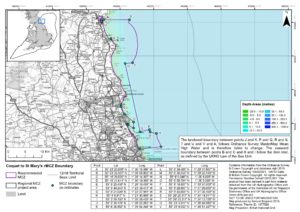
Overview of the Management Plan Development Process
This page outlines the process behind developing the management plan, including:
• The rationale for the plan
• Key decisions made at each stage
• Industry feedback and how it was considered
• Plan details and provisions
• The review process
Why is this management plan needed?
NIFCA recognises that this plan introduces changes to the inshore trawl fishery and anticipates questions such as, “If it isn’t broken, why fix it?” We aim to clearly explain the rationale behind the plan and its necessity.
Under the Marine and Coastal Access Act 2009, IFCAs have a legal duty to ensure conservation objectives of any Marine Conservation Zone (MCZ) are progressed (Section 154). NIFCA must therefore assess all fishing activity within the Coquet to St Mary’s MCZ (CSM MCZ) for its impact on protected features, including mud and sand habitats.
The CSM MCZ spans from Alnmouth Bay to St Mary’s Island, extending up to three miles offshore. Due to the presence of sensitive intertidal and subtidal features, all commercial fishing within the zone must be assessed for its potential impact on the MCZ’s conservation objectives.

MCZ Assessment Summary
NIFCA assessed each feature/fishery interaction, including the impact of trawling on subtidal mud. Using the best available evidence—local studies, national research, and data on otter trawling intensity—the assessment could not rule out adverse impacts. Findings suggest that trawling may be hindering the conservation objectives due to abrasion, disturbance, and removal of non-target species.
Although the mud feature is assumed to be in favourable condition, a lack of condition monitoring data makes management challenging.
Further Reading
